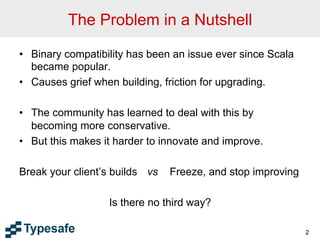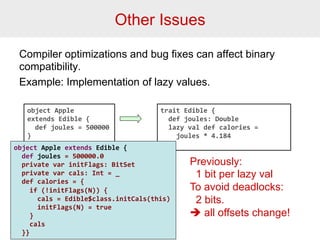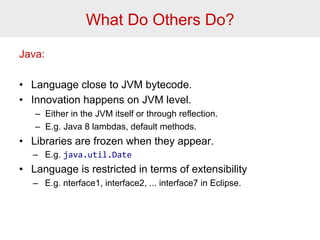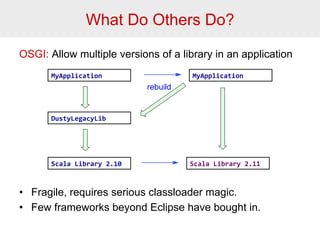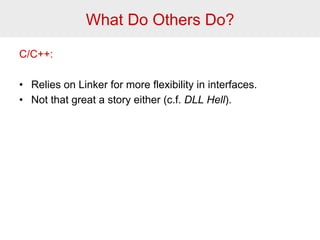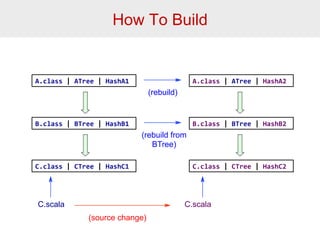Scalax
- 1. The Binary Compatibility Challenge Martin Odersky Typesafe and EPFL
- 2. The Problem in a Nutshell • Binary compatibility has been an issue ever since Scala became popular. • Causes grief when building, friction for upgrading. • The community has learned to deal with this by becoming more conservative. • But this makes it harder to innovate and improve. Break your client’s builds vs Freeze, and stop improving Is there no third way? 2
- 3. What is Binary Compatibility? Binary compatibility ≠ Source compatibility Source & binary incompatible object Client { msg.length } object Server { val msg = “abc” } object Server { val msg = Some(“abc”) }
- 4. What is Binary Compatibility? Binary compatibility ≠ Source compatibility Source incompatible, binary compatible: object Client { import a, b val x: String = 1 } object a { implicit def f(x: Int): String = x.toString } object b object a { implicit def f(x: Int): String = x.toString } object b { implicit def g(x: Int): String = ”abc” }
- 5. What is Binary Compatibility? Binary compatibility ≠ Source compatibility Source compatible, binary incompatible: object Apple extends Edible { def joules = 500000 } trait Edible { def joules: Double } trait Edible { def joules: Double def calories = joules * 4.184 } èNeed to recompile on Java 1-7 In Java 8 it’s more complex but fundamentally the same.
- 6. What is Binary Compatibility? Binary compatibility ≠ Source compatibility Source compatible, binary incompatible: object Apple extends Edible { def joules = 500000 } trait Edible { def joules: Double def calories: Double } trait Edible { object def Edible$joules: class Double { } def calories($this: Edible): Double = $this.joules * 4.184 trait Edible { def joules: Double def calories = joules * 4.184 } } object Apple extends Edible { def joules = 500000.0 def calories: Double = Edibl$class.calories(this) } èNeed to recompile on Java 1-7 In Java 8 it’s more complex but fundamentally the same.
- 7. Other Issues Compiler optimizations and bug fixes can affect binary compatibility. Example: Implementation of lazy values. trait Edible { def joules: Double lazy val def calories = joules * 4.184 } object Apple extends Edible { def joules = 500000 } object Apple extends Edible { def joules = 500000.0 private var initFlags: BitSet private var cals: Int = _ def calories = { if (!initFlags(N)) { cals = Edible$class.initCals(this) initFlags(N) = true } cals }} Previously: 1 bit per lazy val To avoid deadlocks: 2 bits. è all offsets change!
- 8. Compiler Pipeline Parser Typer SyntheticMethods SuperAccessors RefChecks ElimRepeated ElimLocals ExtensionMethods TailRec PatternMatcher ExplicitOuter Erasure Mixin Memoize LazyVals CapturedVars Constructors LambdaLift Flatten RestoreScopes Cleanup more GenBCode phases Source Symbols JVM Byte-code Lots of scope for things to go wrong!
- 9. Where It Breaks A.class C.class C.class C.scala C.scala (binary incompatible source change)
- 10. Why Is This Such a Big Problem? MyApplication DustyLegacyLib Scala Library 2.10 X can’t upgrade to (too old, can’t rebuild) Scala Library 2.11 Seq.scala Seq.scala (binary incompatible source change) Scala 2.11!
- 11. Not Just A Problem with Scala-Library MyApplication DustyLegacyLib Akka 3.2 X can’t upgrade to (can’t rebuild) Akka 3.3 Actor.scala Actor.scala (binary incompatible source change) Akka 3.3!
- 12. Not Just A Problem with Scala-Library MyApplication DustyLegacyLib shapeless 2.0 X can’t upgrade to (can’t rebuild) shapeless 2.1 unions.scala unions.scala (binary incompatible source change) shapeless 2.1!
- 13. Dealing With It So Far “MiMa” tool can detect binary incompatibilities. Scala release policy: – Minor versions need to be (forwards and backwards) binary compatible. – Major versions are allowed to break binary compatibility – Major versions are released rarely (+18 months between them). Problem: – 3rd party libraries need similar policies but often don’t enforce them. – Innovation is stifled. – Simple fixes have to wait for a long time to get in. – Lots of dev cycles spent on dealing with binary compatibility.
- 14. What Do Others Do? Java: • Language close to JVM bytecode. • Innovation happens on JVM level. – Either in the JVM itself or through reflection. – E.g. Java 8 lambdas, default methods. • Libraries are frozen when they appear. – E.g. java.util.Date • Language is restricted in terms of extensibility – E.g. nterface1, interface2, ... interface7 in Eclipse.
- 15. What Do Others Do? OSGI: Allow multiple versions of a library in an application MyApplication DustyLegacyLib Scala Library 2.10 MyApplication Scala Library 2.11 rebuild • Fragile, requires serious classloader magic. • Few frameworks beyond Eclipse have bought in.
- 16. What Do Others Do? C/C++: • Relies on Linker for more flexibility in interfaces. • Not that great a story either (c.f. DLL Hell).
- 17. What Do Others Do? Clojure: • Builds from source.
- 18. What Do Others Do? Javascript: • Builds from source.
- 19. What Do Others Do? Python: • Builds from source.
- 20. What Do Others Do? Ruby: • Builds from source.
- 21. What Do Others Do? Go: • Builds from source.
- 22. Why Can’t Scala Build from Source? No standard Build Tool Should we standardize on SBT, Gradle, Maven, Ivy, Ant? Reproducible builds are rare. Chicken and egg problem: Because everyone is used to binary builds, nobody* invests in making builds reproducible *Not quite true: Typesafe has invested in community build, can now build more than 1M lines of community projects. But it’s a huge effort.
- 23. What We Need • An interchange format that captures the essence of Scala dependencies. • This cannot be the JVM bytecode format • Nor can it be source 23
- 24. The Idea Use Typed Trees as an interchange format. – More robust than source. – More stable than JVM bytecode. – Efficient?
- 25. New Compiler Pipeline Parser Typer SyntheticMethods SuperAccessors RefChecks ElimRepeated ElimLocals ExtensionMethods TailRec PatternMatcher ExplicitOuter Erasure Mixin Memoize LazyVals CapturedVars Constructors LambdaLift Flatten RestoreScopes Cleanup GenBCode Typed Trees Typed Trees Source Frontend Backend Bytecode
- 26. How To Build A.class | ATree | HashA1 B.class | BTree | HashB1 C.class | CTree | HashC1 A.class | ATree | HashA2 B.class | BTree | HashB2 C.class | CTree | HashC2 (rebuild from BTree) C.scala C.scala (source change) (rebuild)
- 27. More Robust Than Source Source Parser Typer SyntheticMethods SuperAccessors Typed Trees Frontend Ø Resolve Names Ø scan packages Ø handle imports Ø establish implicit scopes Ø Resolve Overloading Ø Find Implicits Ø Apply Conversions Ø Infer Type Parameters Ø Assign Types to Trees (5374 lines) A lot can go wrong here!
- 28. More Robust Than Source RefChecks ElimRepeated ElimLocals ExtensionMethods TailRec PatternMatcher ExplicitOuter Erasure Mixin Memoize LazyVals CapturedVars Constructors LambdaLift Flatten RestoreScopes Cleanup GenBCode Typed Trees Backend Bytecode Assign Types (311 lines)
- 29. More Resilient Than Bytecode Can – add fields and methods to traits – add lazy vals anywhere – change compilation scheme in any way necessary. None of these would be binary compatible! Can also – add or remove implicits – add methods anywhere – change imports All of these could be source incompatible!
- 30. Efficient? Can typed trees be efficient enough to build million+ line systems? Possible issues: • Size of trees – on disk – in memory • Transformation time 30
- 31. Potential Issue: Tree Size xs.filter(_ = 0) becomes: Apply Select Ident “filter” “xs” :: Block DefDef “anonfun” :: :: ValDef “$x” Nil Nil Nil TypeTree: Int Apply Select Ident “$x” “=” Literal 0 Literal “anonfun” :: 16 Nodes, Nil not counting types 17 chars
- 32. Back of the Envelope Calculation: 16 nodes Average size of node: 32 bytes 512 bytes total. Double that to include type info. è 16 bytes source à 1KB tree (factor 64 blow-up). For a 1M line system 30MB source à 2GB trees. 32
- 33. A More Compact Representation Apply (34) SelectTermWithSig (9) Ident (3) “xs” “filter” “Function1 -‐ Boolean” Closure (23) ParamDef (7) “x” TypeRef “scala.Int” Apply (14) SelectTermWithSig (9) Ident (3) “x$” “=“ “Integer -‐ Boolean” Literal (3) 0 33 Still navigable, because inner nodes contain size of total tree derived from them Types or symbols given at the leaves. Types of inner nodes are reconstituted using the TypeAssigner.
- 34. Speed Transformation + byte-code generation amounts to ~ 60% of total compile time. We can speed this up by – fusing phases, reducing amount of intermediate trees, – using a fast type assigner, instead of a slow typer, – building different files in parallel. Besides, can use incremental compilation. – Compile only this units that depend on changed libraries. – Need to do that only once. 34
- 35. Other Benefits Optimization – Typed trees are a great format for interprocedural analyses – Inlining across compilation units made simple – Inlining without binary compatibility issues Program Analysis – Types trees are close to source, but easy to traverse – Ideal for context-dependent program analyses such as FindBugs – Ideal for instrumentation Portability – Typed trees allow retargeting to different backends, as long as dependencies exist. – Allow libraries to be used on JVM, JS, LLVM... without needing explicit recompilation. 35
- 36. Common Intermediate Format 36 New Backend dotc Frontend scalac Frontend Old Backend GenBCode Bytecode
- 37. Conclusion 37 Typed trees can fix the binary compatibility problem and they offer lots of other benefits, too. Let’s start the work to make them real!

